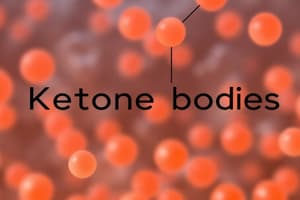Podcast
Questions and Answers
What is the primary function of Carnitine Palmitoyltransferase (CPT) enzymes?
What is the primary function of Carnitine Palmitoyltransferase (CPT) enzymes?
- Convert acyl-carnitine back into acyl-CoA
- Transport fatty acids into mitochondria (correct)
- Package triglycerides into chylomicrons
- Convert fatty acids to acetyl-CoA
What is the primary function of acyl-CoA synthetase enzymes?
What is the primary function of acyl-CoA synthetase enzymes?
- Package triglycerides into chylomicrons
- Convert fatty acids to acetyl-CoA (correct)
- Convert acyl-carnitine back into acyl-CoA
- Transport fatty acids into mitochondria
What is the primary function of Beta oxidation or fatty acid oxidation?
What is the primary function of Beta oxidation or fatty acid oxidation?
- Package triglycerides into chylomicrons
- Convert acyl-CoA into acetyl-CoA (correct)
- Convert acyl-carnitine back into acyl-CoA
- Transport fatty acids into mitochondria
What is the primary function of ketone bodies?
What is the primary function of ketone bodies?
What is the primary function of the liver-specific enzyme HMG-CoA lyase?
What is the primary function of the liver-specific enzyme HMG-CoA lyase?
What is the primary function of the ketogenic diet?
What is the primary function of the ketogenic diet?
What is the primary function of ketones during starvation conditions?
What is the primary function of ketones during starvation conditions?
What is the primary complication of elevated levels of ketones in the blood?
What is the primary complication of elevated levels of ketones in the blood?
What is the process by which fatty acids are imported into mitochondria for oxidation?
What is the process by which fatty acids are imported into mitochondria for oxidation?
What is the end product of beta oxidation?
What is the end product of beta oxidation?
What is the purpose of ketone bodies during times of fasting?
What is the purpose of ketone bodies during times of fasting?
What is the liver-specific enzyme responsible for cleaving HMG-CoA to produce acetoacetate and acetyl-CoA?
What is the liver-specific enzyme responsible for cleaving HMG-CoA to produce acetoacetate and acetyl-CoA?
What is the main source of ketone bodies during a ketogenic diet?
What is the main source of ketone bodies during a ketogenic diet?
What are the two main ketone bodies generated during times of fasting?
What are the two main ketone bodies generated during times of fasting?
What is the potential complication of elevated levels of ketones in the blood?
What is the potential complication of elevated levels of ketones in the blood?
What is the purpose of fatty acid oxidation during fasting?
What is the purpose of fatty acid oxidation during fasting?
Flashcards
Fatty acid oxidation
Fatty acid oxidation
The breakdown of fatty acids into acetyl-CoA, producing energy (ATP), FADH2, and NADH.
Acetyl-CoA
Acetyl-CoA
A key molecule in metabolism, often produced from fatty acid breakdown and used to generate energy
Beta oxidation
Beta oxidation
A series of reactions that break down fatty-acyl-CoA into acetyl-CoA, NADH, and FADH2.
Carnitine Shuttle
Carnitine Shuttle
Signup and view all the flashcards
Ketone bodies
Ketone bodies
Signup and view all the flashcards
Ketogenesis
Ketogenesis
Signup and view all the flashcards
Fatty acid absorption
Fatty acid absorption
Signup and view all the flashcards
Chylomicrons
Chylomicrons
Signup and view all the flashcards
CPT enzymes
CPT enzymes
Signup and view all the flashcards
Acyl-CoA synthetase
Acyl-CoA synthetase
Signup and view all the flashcards
Diabetic Ketoacidosis
Diabetic Ketoacidosis
Signup and view all the flashcards
Ketogenic Diet
Ketogenic Diet
Signup and view all the flashcards
Glucose sparing
Glucose sparing
Signup and view all the flashcards
Gluconeogenesis
Gluconeogenesis
Signup and view all the flashcards
Brain energy dependence
Brain energy dependence
Signup and view all the flashcards
Study Notes
Metabolism of Fatty Acids and Ketone Bodies
-
Fatty acids from dietary triglycerides are broken down into component fatty acids and monoglycerides in the small intestine, absorbed, converted to triglycerides, packaged into chylomicrons, and shipped out into circulation.
-
Fatty acids can be cleaved into their component fatty acids through a series of enzymes and converted into acetyl-CoA in target tissues for energy.
-
Fatty acids are imported into mitochondria for fatty acid oxidation pathways through a series of enzymes called Carnitine Palmitoyltransferase (CPTs).
-
Acyl-CoA synthetase enzymes convert fatty acids into acyl-CoA by attaching a co-enzyme molecule to a fatty acid in the cytoplasm.
-
CPT I takes the acyl-CoA, transfers the fatty acid group to a molecule of carnitine in the cytoplasm, and converts the acyl-CoA into acyl-carnitine.
-
CPT II converts acyl-carnitine back into acyl-CoA in the matrix of the mitochondria.
-
Beta oxidation or fatty acid oxidation converts acyl-CoA into acetyl-CoA, generating FADH2, NADH, and an acetyl-CoA molecule with each cycle.
-
Beta oxidation generates a lot of energy, with 108 ATP molecules generated from a 16 carbon fatty acid.
-
The brain cannot effectively use fatty acids for energy, so ketone bodies are generated from acetyl-CoA in the liver mitochondria during times of fasting/starvation.
-
Ketone bodies, including Acetoacetate and Hydroxybutyrate, are four carbon molecules that can be taken up by the brain and used for energy.
-
Ketones are only synthesized in the liver and released by the liver, and are used for energy during times of fasting and low blood sugar.
-
Ketogenic diets are based on the generation of ketones from the release of large amounts of fatty acids, which are converted into ketones and taken up by the brain.Ketones and Ketogenesis: The Process, Function, and Complications
-
Ketones are generated from acetyl-CoA in the liver during times of high fat intake, fasting, or untreated diabetes.
-
The brain is heavily reliant on glucose metabolism and cannot survive in its absence.
-
During fasting, the liver and muscle tissues shift from glucose to fatty acid metabolism to preserve glucose for the brain.
-
Ketogenesis is similar to beta oxidation, with acetyl-CoA being converted to acetoacetyl-CoA and then to HMG-CoA.
-
The liver-specific enzyme HMG-CoA lyase cleaves HMG-CoA to produce the ketone body acetoacetate and acetyl-CoA.
-
Ketone bodies are transported to target tissues, where they are converted back to acetyl-CoA for energy.
-
Ketone bodies lower the demand for glucose in the brain during starvation conditions and reduce the amount of protein broken down for gluconeogenesis.
-
Elevated levels of ketones in the blood, as seen in diabetic ketoacidosis or severe alcoholism, can lead to acidosis and complications.
-
The ketogenic diet, which involves low sugar and high fat intake, can be therapeutic for conditions such as glut1 deficiency, which reduces glucose uptake by the brain and causes seizures.
-
Ketones produced during a ketogenic diet can supplement reduced glucose levels in the brain and reduce seizures in patients with glut1 deficiency.
-
Fatty acid oxidation is an important way to generate energy during fasting, with the products of oxidation inhibiting glycolysis and preserving glucose for the brain.
-
Ketones provide a way to transport acetyl-CoA to target tissues and reduce the demand for glucose in the brain during starvation conditions.
Studying That Suits You
Use AI to generate personalized quizzes and flashcards to suit your learning preferences.




